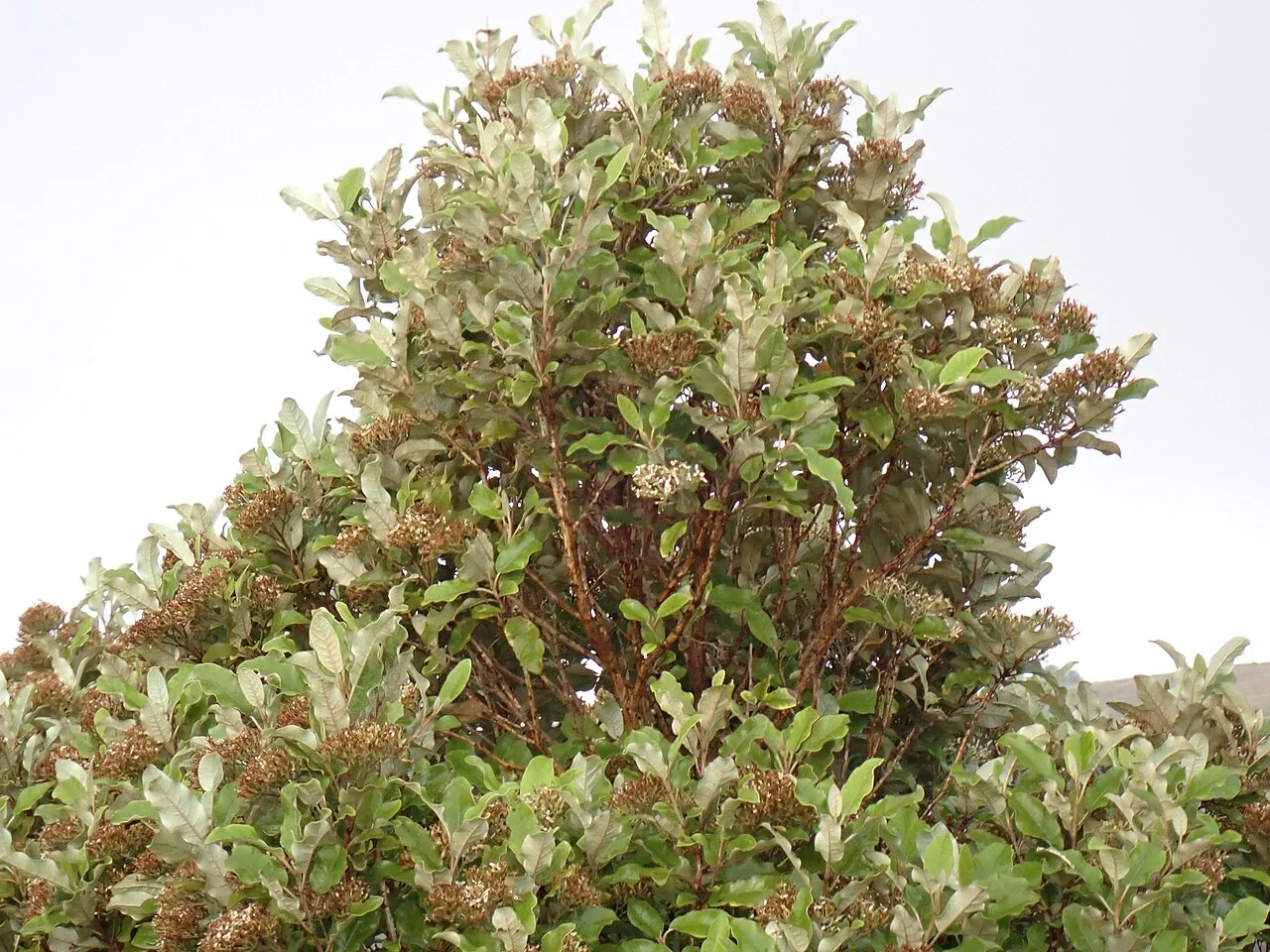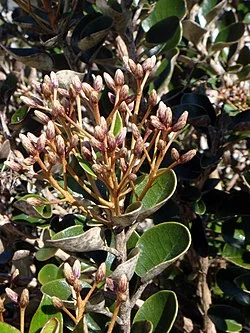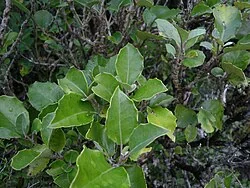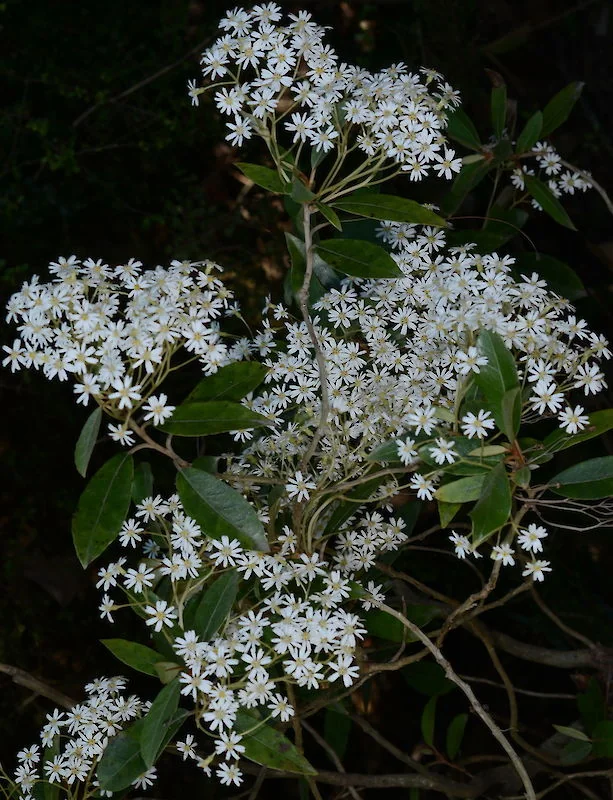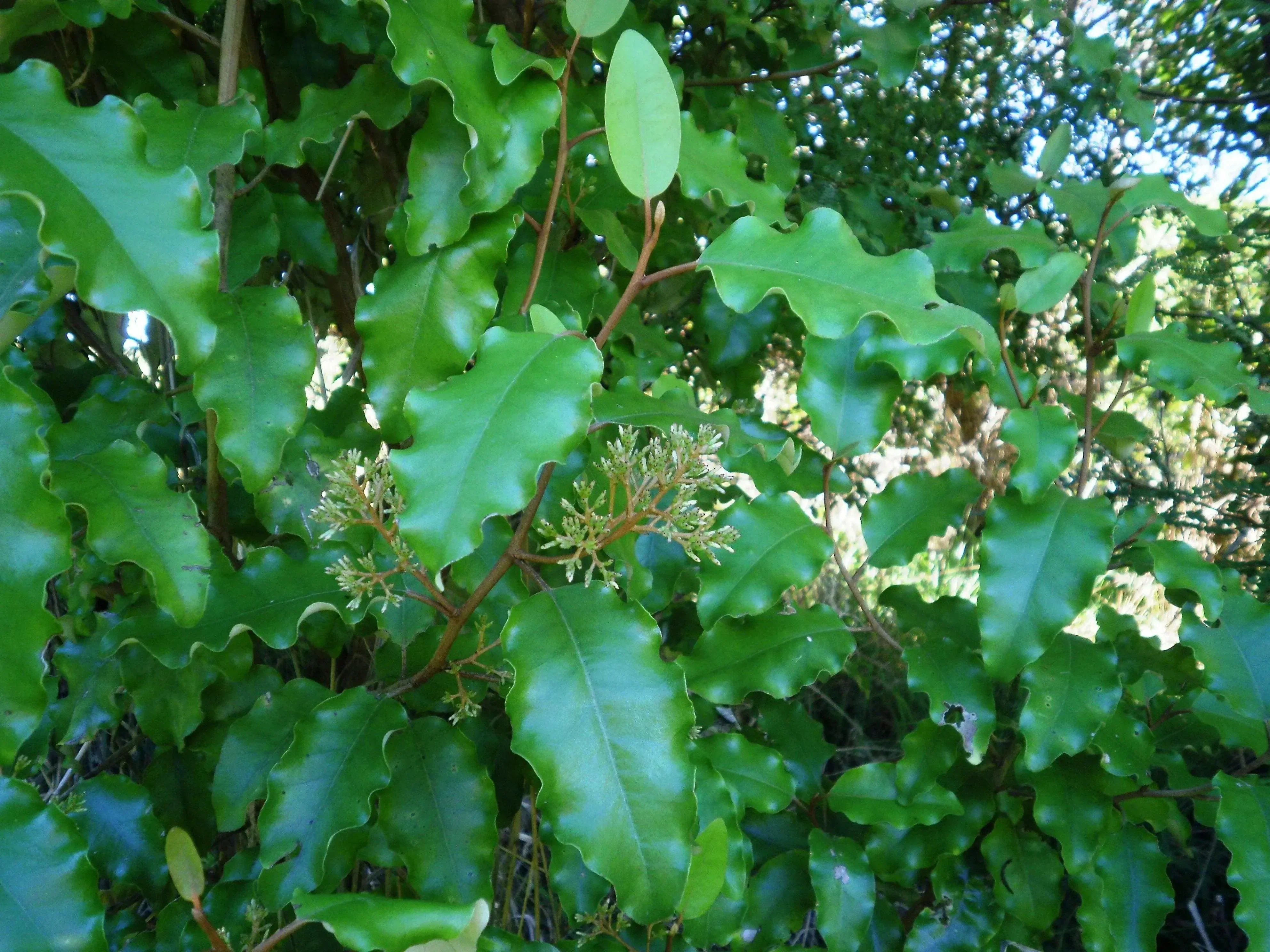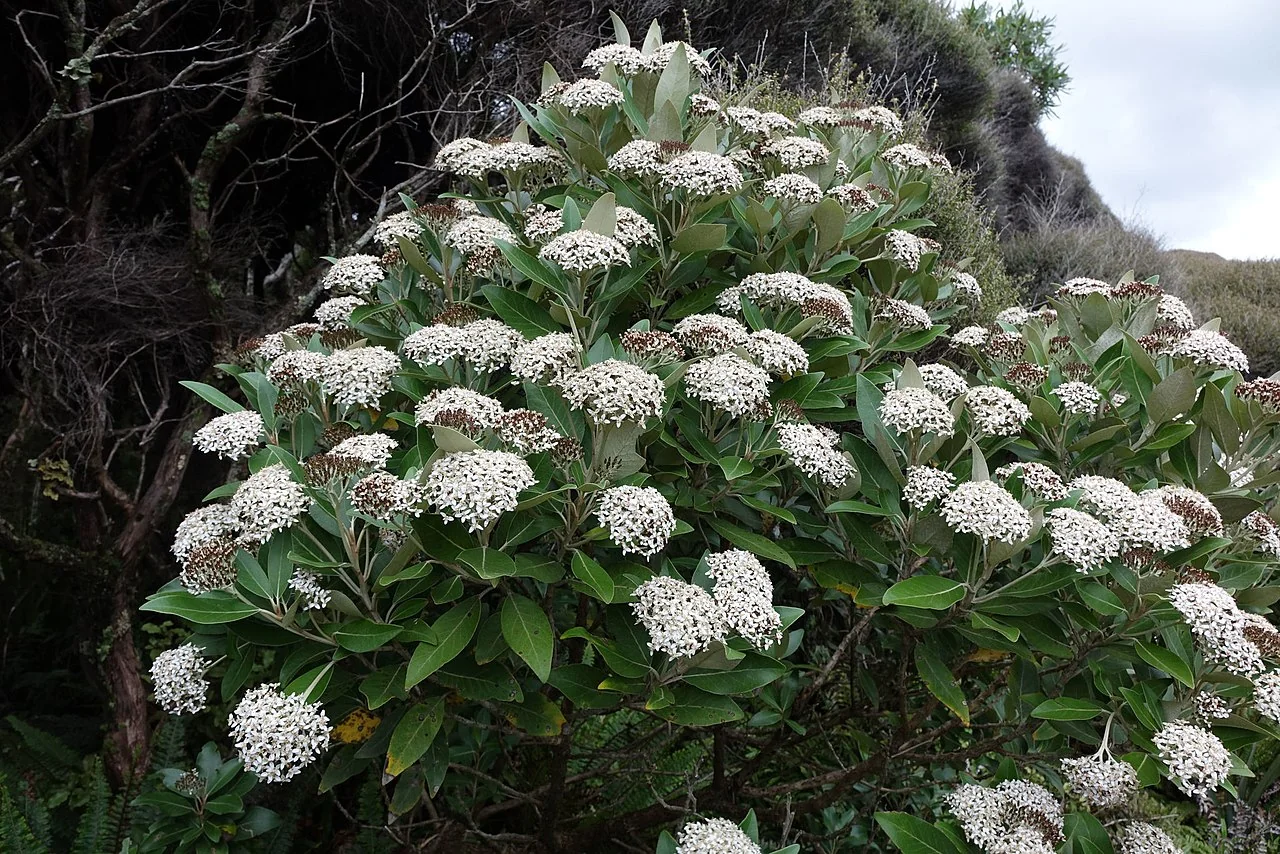
Mountain Akeake
Olearia avicenniifolia
Akeake (scientific name: Olearia avicenniifolia ) Akeake is a native tree daisy that produces masses of small white or cream flowers. Like other Olearia species, it's valued for its hardy nature and ability to provide shelter and nectar for native wildlife. Explore more in the native plants index .

Plant Description
Botanical Features
Māori Uses and Restoration Practice
Mountain Akeake ( Olearia avicenniifolia ) is an evergreen shrub or small tree native to New Zealand, particularly found on the southern coastlines of the South Island and on Stewart Island. It typically grows up to 3 to 6 meters tall and 3 to 5 meters wide. It has leathery, oblong‑lanceolate leaves that are dark green on the upper side and downy white underneath. The leaves are typically 5-10 cm long and 3-5 cm wide. The plant produces clusters of sweetly scented, daisy-like white flowers with purple central disks, emerging from August to September or November to February. These flowers are about 5 centimeters wide and are carried in clusters of three to ten. It is a bushy plant with thin, papery bark and angular branchlets covered in white tomentum.
Quick Facts
Overview
| Scientific Name | Olearia Avicenniifolia |
|---|---|
| Height | 2-6 m |
| Spread | 2-4 m |
| Water Needs | Low to moderate |
| Light | Full sun to partial shade |
| Frost Tolerance | Moderate to good |
| Salt Tolerance | Moderate |
| Growth Rate | Moderate |
| Lifespan | Long-lived |
Climate Best Suited to
Regional climate suitability across major New Zealand cities.
Regional Suitability
| Whangārei | Ideal |
| Auckland | Ideal |
| Hamilton | Suitable |
| Rotorua | Suitable |
| Tauranga | Ideal |
| Gisborne | Ideal |
| New Plymouth | Ideal |
| Whanganui | Ideal |
| Palmerston North | Suitable |
| Napier | Ideal |
| Wellington | Ideal |
| Nelson | Ideal |
| Christchurch | Suitable |
| Dunedin | Suitable |
| Invercargill | Suitable |
| City | Climate Suitability |
|---|
Natural Habitat
Mountain Akeake is an evergreen shrub or small tree endemic to New Zealand, primarily found on the southern coastlines of the South Island and on Stewart Island. It thrives in sub-alpine scrub, occurring from sea-level up to 900-1000 meters in elevation. This species is known to thrive in exposed, windswept, and dry sites, and can tolerate coastal conditions, including salt and frost.
Plant Conservation
Olearia avicenniifolia , commonly known as mountain akeake, is classified as "Not Threatened" in New Zealand. This conservation status has been consistent across multiple assessments, including those in 2004, 2009, 2012, 2017, and the most recent assessment in 2023. Regionally, it is also considered "Regionally Not Threatened" in Otago as of 2024.
Growing Requirements
Soil Requirements
Mountain akeake thrives in free-draining, stony or sandy loams. Avoid heavy, wet soils; excellent choice for rocky, montane gardens.
Light Requirements
Full sun for compact, wind-firm growth; tolerates exposure and frost.
Water Requirements
Low once established; water moderately during prolonged summer droughts.
Planting Guide
1. Ideal Planting Conditions:
- Sun Exposure: Thrives in full sun to partial shade.
- Soil: Prefers free-draining, well-drained soil. It can tolerate a range of soil pH from mildly acidic to very alkaline, including chalky soils, and does well in light loam or peaty soil.
- Hardiness: Hardy to USDA Zones 8-10, tolerating temperatures down to approximately -10°C (14°F) to -15°C (5°F).
- Tolerances: Highly tolerant of maritime exposure, wind, and atmospheric pollution, making it suitable for coastal and exposed environments. It is also considered drought-tolerant once established.
2. Planting Process:
- Spacing: When planting in rows for shelterbelts or screens, space trees about 4-5 meters (13-16 feet) apart to allow for adequate development.
- Preparation: Carefully remove the plant from its container and gently separate the roots. Dig a hole that is wide enough to accommodate the root ball.
- Placement: Position the plant in the centre of the hole, ensuring the best side faces forward.
- Backfilling: Fill the hole with the original soil or an amended mixture if needed, firming it just enough to support the shrub.
Ecological Role
Environmental Benefits
Mountain akeake ( Olearia avicenniifolia ) is a hardy montane shrub that knits together open scrub and forest edges. Summer flowering supplies nectar and pollen to native flies and bees; its dense, twiggy framework provides shelter and nesting opportunities for small birds in high‑country and coastal hill environments.
- Pollinator support: Daisy heads feed generalist native insects in summer.
- Windbreak habitat: Compact canopies create refuges on exposed slopes.
- Soil protection: Root systems help stabilise thin, erosion‑prone soils.
Uses and Significance
Landscape Uses
Olearia avicenniifolia provides cold-hardy shelter, effective hedging, and year-round structure in high-country and coastal plantings. Its dense foliage offers protection and visual appeal, making it a versatile choice for exposed or challenging garden environments.
Ecology
The abundant daisy blooms of Mountain Akeake actively support a diverse array of native pollinators in exposed habitats, contributing significantly to local biodiversity and ecosystem health during its extended flowering season.
Cultural Significance
Cultural Importance
Regional Use and Identity
Known as Mountain akeake, Olearia avicenniifolia is closely associated with the wild, wind-exposed coasts and ranges of Te Waipounamu/South Island and Rakiura/Stewart Island. Its reliability as a shelterbelt and farm-windbreak species has made it a familiar feature of rural landscapes, where it also functions as a resilient native alternative to exotic hedging.
Ecological Connections
The honey-scented summer blooms feed a variety of invertebrates, and the dense crown provides cover for small birds in harsh coastal weather. Incorporating this species into revegetation and coastal-garden plantings supports local biodiversity and maintains the character of native scrub communities on poor, rocky soils.
Horticultural Value
Mountain akeake's fast establishment, salt and wind tolerance, and year-round foliage make it a staple of southern native gardens. Using regionally sourced plants helps retain local genetic identity in restoration and amenity projects.
Landscaping Ideas
Mountain Akeake in Design
- Windbreak hedges: Clips cleanly for compact, wind-tolerant screens.
- Structural shrub: Evergreen backbone in mixed native borders and coastal gardens.
- Pollinator resource: Daisy blooms support beneficial insects in summer.
Best in full sun and free-draining soils; mulch helps in summer-dry regions.
Seasonal Care Calendar
Spring
Spring is an ideal time for planting new specimens or dividing established clumps of Mountain Akeake. Lightly tip-prune to encourage bushiness and promote new growth.
Summer
Ensure new plants receive adequate water, especially during prolonged dry spells. Established plants are quite drought-tolerant and typically require minimal supplementary watering.
Autumn
Perform light shaping or formative pruning after the main flowering period to maintain the desired form and encourage a tidy appearance, preparing for winter.
Winter
Mountain Akeake is generally frost-hardy, requiring no special care in most temperate climates. Ensure good drainage to prevent waterlogging around the roots during wet periods.
Pruning and Maintenance
Techniques and Timing
Mountain Akeake responds well to regular light pruning to maintain its naturally dense, compact habit. Winter is the ideal time for shaping and trimming this hardy shrub. Light clipping after flowering helps encourage bushier growth and removes spent flower heads. As with most Olearia species, avoid hard renovation cuts back into bare wood, as this can be slow to recover and may compromise the plant's natural form.
How to Grow Mountain Akeake
Mountain Akeake is a hardy native tree daisy that forms an attractive, bushy shrub or small tree distinguished by its distinctive white-backed leaves and prolific clusters of small white or cream daisy flowers. This robust member of the Asteraceae family is naturally found in coastal and lowland areas throughout New Zealand, where it has adapted to challenging conditions including salt spray, wind exposure, and variable soil conditions. Mountain Akeake is particularly valued in cultivation for its exceptional hardiness, fast growth rate, and spectacular late-season flowering displays that provide crucial nectar resources when many other plants have finished blooming, making it an excellent choice for wildlife-friendly gardens and coastal restoration projects. Understanding its propagation methods is key to successfully growing this delightful species.
From Cuttings
Semi-hardwood cuttings are a reliable and efficient method for propagating Mountain Akeake, ensuring that new plants retain the exact characteristics of the parent. Take 8-10 cm cuttings from healthy, non-flowering shoots in late summer or early autumn. Dip in rooting hormone and place in a well-draining propagation mix under humidity. Maintain consistent moisture and warmth until roots develop, typically within 6-8 weeks. Once rooted, the new plants can be potted on and grown in a sheltered environment until they are ready for planting.
From Seed
Propagating Mountain Akeake from seed is a viable method, though it requires fresh seeds and careful attention to conditions. Fresh seed can be surface-sown on a free-draining seed-raising mix in autumn. The fine seeds require light to germinate, so avoid covering them deeply. Keep soil evenly moist and provide protection from direct sunlight. Germination can be variable and may take several weeks to months. This method is crucial for maintaining genetic diversity and for large-scale restoration projects.
Pests and Diseases
Hardy but Avoid Wet Feet
- Aphids/scale: Treat with oils/soaps; improve air circulation in hedges.
- Leaf spot: Remove affected material; water at soil level.
- Waterlogging: Plant on low berms or raised beds if soil is heavy.
Bonus Tip
Expert Growing Advice
Mountain akeake ( Olearia avicenniifolia ) handles wind and cold well but dislikes waterlogging. On heavy soils, plant on a low berm and add coarse grit to the top 10 cm to shed winter wet. A late-winter tip prune maintains a bushy form in exposed gardens.
